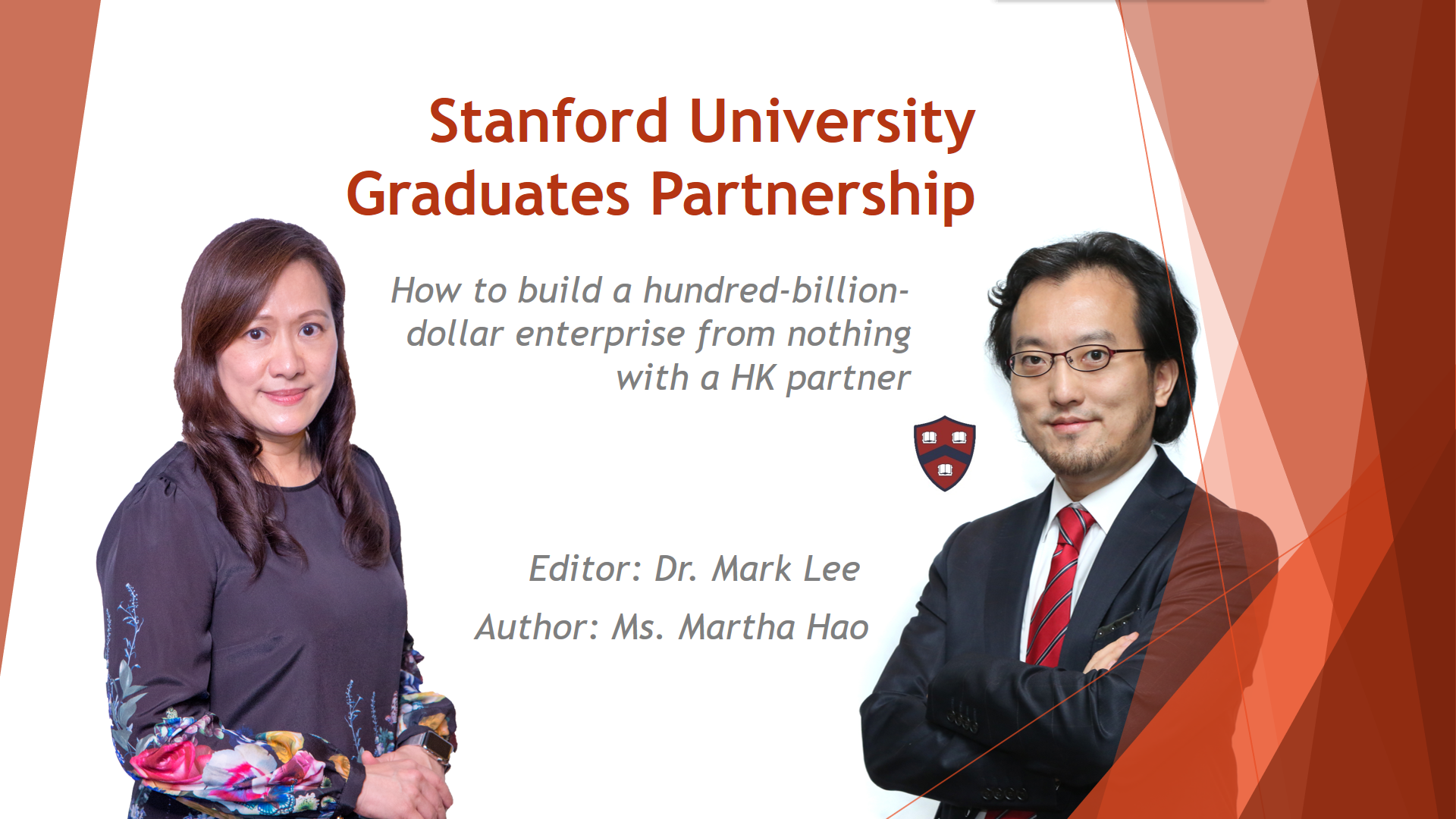
[Stanford University Graduates Partnership]
How to build a hundred-billion-dollar enterprise from nothing with a HK partner
Martha Hao
- Chairman, Hong Kong Medical and Healthcare Device Industries Association
- Business Consultant, Wise Ally International Holdings Limited
- Fellow, Manufacturing Industry, Asia Pacific Institute for Strategy ( 亞研所院士 )
The US unicorn JUUL, just after few years of its establishment, was acquired by Altria Group at a valuation of US$38 billion. The valuation surpassed those of stockX and Airbnb, at a speed four times of that of Facebook.
I am honored to have the opportunity to work closely with JUUL from the conceptual stage to realize its creative ideas into a marketable solution, so that the solution could enter the industrial production field and began mass production.
From the experience gained in this case, I can share how five strategies helped my business partner expand their worth to billions of dollars:
-
Take the initiative to target the most cutting-edge creativity and enter the San Francisco Bay Area to capture opportunities.
-
Obtain insight of the reliability of the innovation team and the feasibility of its creativity from the perspective of an “investor”.
-
Use "design thinking" to quickly realize the creative ideas to Minimum Viable Product (MVP).
-
Use the "supply chain" capabilities of the Guangdong-Hong Kong-Macao Greater Bay Area to achieve mass production.
-
Integrate the eastern and western business ecosystems to explore the mainland's large-scale market, and tap into sustainable business models.
Strategy (1): take the initiative to target the most cutting-edge creativity to capture opportunities in the San Francisco Bay Area, and to promote "co-development" of innovation.
In 2012, I strengthened the expansion of the European and American markets, linking more partners and looking for more cooperation opportunities in the San Francisco Bay Area. During the visit to a start-up company, I met another company called Ploom in the Stanford Research Park. The two founders, James Monsees and Adam Bowen, were graduates of Stanford. They were obsessed with the vaporizing and the charging technologies, and had been trying to commercialize tthem, encasing the vaporizing and charging technologies within a very thin shell.
Strategy (2): Obtain insight of the reliability of the innovation team and the feasibility of its creativity from the perspective of an “investor”
Some entrepreneurial teams are creative, but did they invest directly in the "starting from scratch" stage? With an investor’s sense of smell, I observed that: on the team, the founders were very knowledgeable and passionate about technology. Together with their good business sense, they had the premise of diversification, and used their strengths to develop core product, with the potential to also extend the technology to other products. In terms of capital guarantee, it was found that they had a very strong financial group behind them. In terms of commercial extension, the industry in the US market was rising, the global market was larger, and the China market was a Blue Ocean. From these perspectives, I decided to assist that start-up, and the founders of JUUL fully believed in our capabilities in product design optimization, process design, supply chain integration, and comprehensive production.
Strategy (3), while building MVP with "design thinking", strengthen the Techno-Commercial Viability Assessment ("TCVA") test to quickly verify the possibility of "mass production".
Many product designs are derived from "life" and from cross-sector "designs". "Disposable pod like Nespresso!" was the original idea of JUUL, and there were different "flavor" designs. Could the design be mass produced? For start-ups, often good ideas and products could be stifled in the "mass production" stage. I conducted a comprehensive TCVA test on the project. Thanks to our decades of research and development of electro mechanical modules technology, and our experiences in design to manufacturability, we ensured controllability of technology, product process, cost and time.
Strategy (4), use the “supply chain” capabilities of the Guangdong-Hong Kong-Macao Greater Bay Area to achieve mass production.
In today's globalized supply chain, Hong Kong enterprises are supported by the mainland's "super supply chain" and can quickly develop supply chain capabilities. Before entering into mass production, I assisted JUUL in establishing filling and packaging operations in the United States, building logistics centers in Hong Kong, introducing component production in Dongguan, Shenzhen, and other places in China, and connecting the Guangdong-Hong Kong-Macao Greater Bay Area with the San Francisco Bay Area.
Strategy (5), integrate Eastern and Western business ecosystems, explore mainland scale markets, and tap sustainable business models.
American companies naturally handle the US market well, but to face the Chinese market or leverage China’s supply capacity, many issues still need to be dealt with, such as coordinating their trademark registration and copyright implementation, suggesting that they track counterfeit products in China. These products are disassembled and benchmarked for differences.
From the above cases, more Hong Kong companies can take the initiative to get to the forefront to obtain business insights, make judgments from the perspective of investors, use the most feasible industrial technology, ensure that products can be scaled to the market need, and further extend the commercial value. I believe that enterprises can gain more room for development through these five strategies.
Related Articles:
[Crisis Management for the Pandemic]Portfolio Management and Best Practice: The Rule of 30%
[Change Mgt for the Pandemic] 6 Tactics and Pitfalls to Win People's Hearts to Change Effectively
[Crisis Management for the Pandemic]Trend and Crisis Management:The Worst of Time, The Best of Time
《Tai Hing 3.0》Foreword by Dr. Mark Lee:Upgraded Strategy, Advanced Enterprise
[CEO Insights]Crystal Interview:Management Philosophy for an Enterprise from Zero to Billions
[CEO Coaching]Octopus Interview: Innovative Thinking Strategy
[CEO Coaching]BEA Interview: Development Opportunities for Hong Kong Banking Industry
[CEO Coaching]Pfizer Hong Kong Exclusive Interview:What makes a successful enterprise?
[CEO Coaching]Ericsson (HK) Limited Interview:Would Hong Kong lose its competitive edge in 5G era?
Australia: +61 3 9015 4991
Singapore: +65 6850 5067
Hong Kong: +852 3970 1828
Email: cs@apifs.net
Asia Pacific Institute for Strategy (C) 2025

